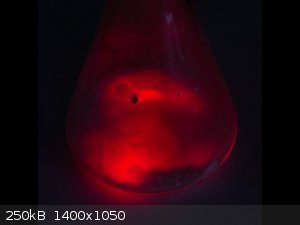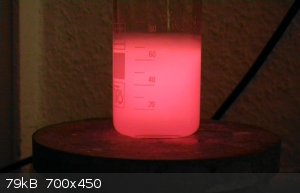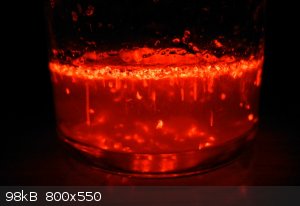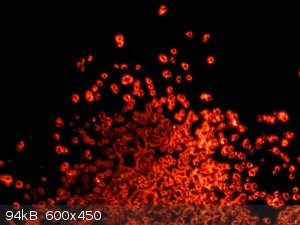
Kagutsuchi - 17-11-2016 at 13:09
I wanna ask you to list as many reactions giving red chemiluminescence as possible.  thanks
thanks
Metacelsus - 17-11-2016 at 13:47
Singlet oxygen formation from peroxide and hypochlorite is accompanied by red chemiluminescence.
For more reactions, use Google.
careysub - 17-11-2016 at 14:26
Woelen recommends also doing the singlet oxygen demonstration with sodium dichloroisocyanurate, providing a more controlled, longer lasting reaction
than hypochlorite (found in Clorox Control Bleach Crystals, and many pool products).
Many chemoluminescent reactions rely on a phosphor to emit light, two common, inexpensive phosphors used for this are Rhodamine 6G and Rhodamine B.
Dr.Bob - 18-11-2016 at 19:58
The great thing about the oxalate esters and peroxide is that the reaction generates excited state CO2 which can transfer its excited state to almost
any dye, so the same reaction can create almost any color by using one or more dyes, the Rhodamine family being some good red ones. Few other
reactions have that level of control over the color output, many other chemiluminescence reactions generate green light.
nezza - 21-11-2016 at 00:33
Here's a picture of the red chemiluminescence from Woelen's method. Thanks for the method Woelen.

Pok - 24-11-2016 at 10:35
CL with manganese ions:

CL with Ru-bipy:

CL with Woehlers Siloxene:

Fidelmios - 24-11-2016 at 16:06
I tried making a copper sulfate and NaDCC reaction with some water purification tablets I got on enay, however the NADCC was only 1% and the reaction
didn't proceed. Anyone know where o could buy some Nadcc?
j_sum1 - 24-11-2016 at 16:27
Around here NaDCCA is available pure as a pool chemical in the supermarkets and hardware stores.
Look up pool suppliers in your area and you should find it.
Fidelmios - 24-11-2016 at 18:58
Tried and for the most part was met with ignorance over the phone. This shall be my quest.
phlogiston - 25-11-2016 at 06:15
The red biolumiscence seen in fish from the Malacosteid family
Herr Haber - 25-11-2016 at 06:44
Try looking in your supermarket near the bleach / household products. It can be found in pellets quite easily.
careysub - 25-11-2016 at 12:24
The Clorox Control Bleach Crystals I mentioned has a content of 10%, and is available everywhere in the U.S.
Fidelmios - 25-11-2016 at 13:19
I wonder if that will suffice to make Cu NaDCC

 thanks
thanks